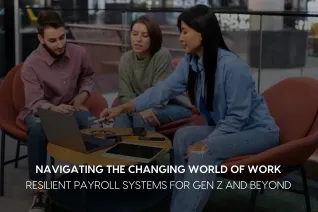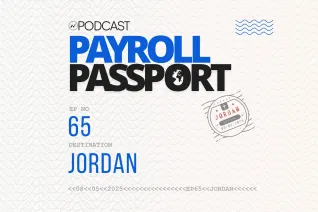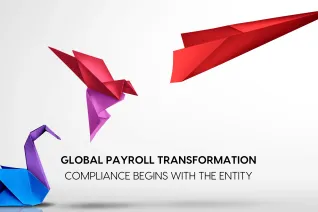Cutting Through the Clutter: Streamlining your HR Tech stack

Managing human resources? New hats keep piling on as you manage distributed teams across the globe? The challenges are endless - from hiring to maintaining employee information, tracking attendance, processing payroll, and fostering engagement among a dispersed workforce. Just when you think you've got it under control, those pesky compliance obligations rear their head.
It's no wonder that in recent years, 83% of HR managers have expressed feelings of overwhelm.
Introducing multiple new tools to your HR Stack might seem like a lifeline, but success lies in how seamlessly they mesh with your primary HRIS, and that's what we're going to discuss in this blog.
Ready to streamline like a pro? Let's dive in!
01. Assess your existing model
According to a recent Gartner survey, 56% of HR leaders feel that their current HR technology solutions and strategies aren't aligned with their present and future business requirements. First things first, take a step back and assess your tech stack. What workflows are essential for your operations? Are there any glaring gaps in your current setup? Make a list of all the tasks and processes you need to handle. This will serve as your roadmap as you navigate the streamlining process.
Here are some key questions to keep in mind during this evaluation process:
- Does your HR system possess the flexibility to seamlessly integrate various modules as your needs evolve?
- Does it offer multilingual support to cater to the diverse linguistic needs of your workforce?
- Is there a user-friendly self-service portal in place?
- Are your workflows automated to minimize manual intervention?
- Does your system include a service desk feature to address employee queries and concerns promptly?
- Can it handle the complexities of managing multi country payroll while ensuring compliance with global regulations?
Pose a variety of questions to yourself and craft a detailed use case sheet outlining your requirements. Engage stakeholders as necessary and align everything with the employee lifecycle. When selecting your HRIS or any integration module, ensure it aligns with your use case sheet.
02. HRIS Check - Getting the foundation right
HRIS needs no introduction – it's a must-have regardless of your organization’s size. But how do you choose the right HRIS system? Simple: count your employees, measure your growth trajectory, and choose your HRIS accordingly. Don't rush. On average, companies spend 15 weeks selecting an HRIS.
If you're a small business with around 25 employees, a basic HRIS system can meet your needs and save you money. But as your company scales to hundreds or even thousands of employees, it's time to invest in a comprehensive HRIS. Managing a larger workforce involves more than just what you see on paper. From time tracking and absence management to performance evaluations, benefits administration, expense management, and reimbursements – an advanced HRIS is indispensable.
For organizations with an international workforce, the stakes are even higher. Choosing a robust HRIS that offers a suite of ancillary solutions and integrations is crucial. Your system should seamlessly handle different languages, currencies, and compliance requirements, ensuring smooth operations across all regions. And on the security front, prioritize features like strong encryption, GDPR compliance, access controls, and regular security audits. A secure HRIS is fundamental for building a reliable and safe HR tech infrastructure.
03. Invest in Key HR Modules
Once your HRIS is in place, it's time to power up your toolkit with core integrations that act as your operational backbone, freeing you up to focus on what truly matters – your people and strategic goals. Think of these integrations as your trusty sidekicks, handling tasks like time management, absence tracking, performance reviews, service desk support, payroll processing, and the seamless onboarding and offboarding of employees.
But depending on your business needs, you might need additional modules like benefits administration, visa management, or compliance monitoring, especially if you're managing a global workforce. However, it's crucial to ensure that each tool you add not only fits your specific requirements but also plays nicely with your HRIS. Without it, you risk drowning in a sea of disjointed data, hampering your ability to keep operations running smoothly.
ALSO READ | Long-Tail-HR operations key challenges and how to overcome them
04. Automate Workflows
With the groundwork laid for your HRIS and key tools seamlessly integrated, it's time to focus on optimizing workflows. By refining workflows, you can eliminate bottlenecks, improve collaboration, and enhance overall efficiency.
Consider the onboarding process, for instance. Traditionally, it could consume 5-6 hours of a HR professional's time. However, with automation, initiating the onboarding process for a new employee is a breeze; the system takes care of everything, including screening. Similarly, you can create workflows for tasks such as document signing, automatic notifications, payroll processing, expense management, and benefits administration. All you require is an application that seamlessly integrates with your HRIS to achieve this.
Explore the Neeyamo HR workforce management stack - You don’t need to search for separate modules; everything is readily integrated with the employee hub.
05. Enhance Employee Self-Service Portal
In today's digital landscape, employees crave autonomy and efficiency in managing their tasks. If your employees are still relying on you for various requests, it's time to change that dynamic. The stats from Gartner indicate that 63% of employees cease using technology if they don’t perceive its relevance to their day-to-day tasks. Therefore, the system should be designed to accommodate all user types and provide value to them. Achieving this level of efficiency is possible through the integration of the aforementioned three processes. Once fully integrated, all your data resides within a single system, making it seamless for the Employee Self-Service (ESS) portal to retrieve any required information swiftly.
In a nutshell, everything we've covered is like a cornerstone for businesses, whether they're small startups or large corporations. The main point to remember is the value of integration and unifying all functions onto one platform. And when the right tech steps in, it's like a smooth ride for both your people and processes. So, you can focus on what really matters: strategic planning and big moves!
Here at Neeyamo, we're all about simplifying life for both employers and employees, offering a seamless, all-in-one platform experience. Plus, all our modules are integration-ready, allowing you to effortlessly plug and play with your existing systems. Learn more about how Neeyamo can help streamline your HR Tech stack. Reach out to Irene Jones at irene.jones@neeyamo.com.
Latest Resources
Stay informed with latest updates
If you're curious and have a thirst for knowledge pertaining to the HR, payroll, and EOR universe, don't miss out on subscribing to our resources.















